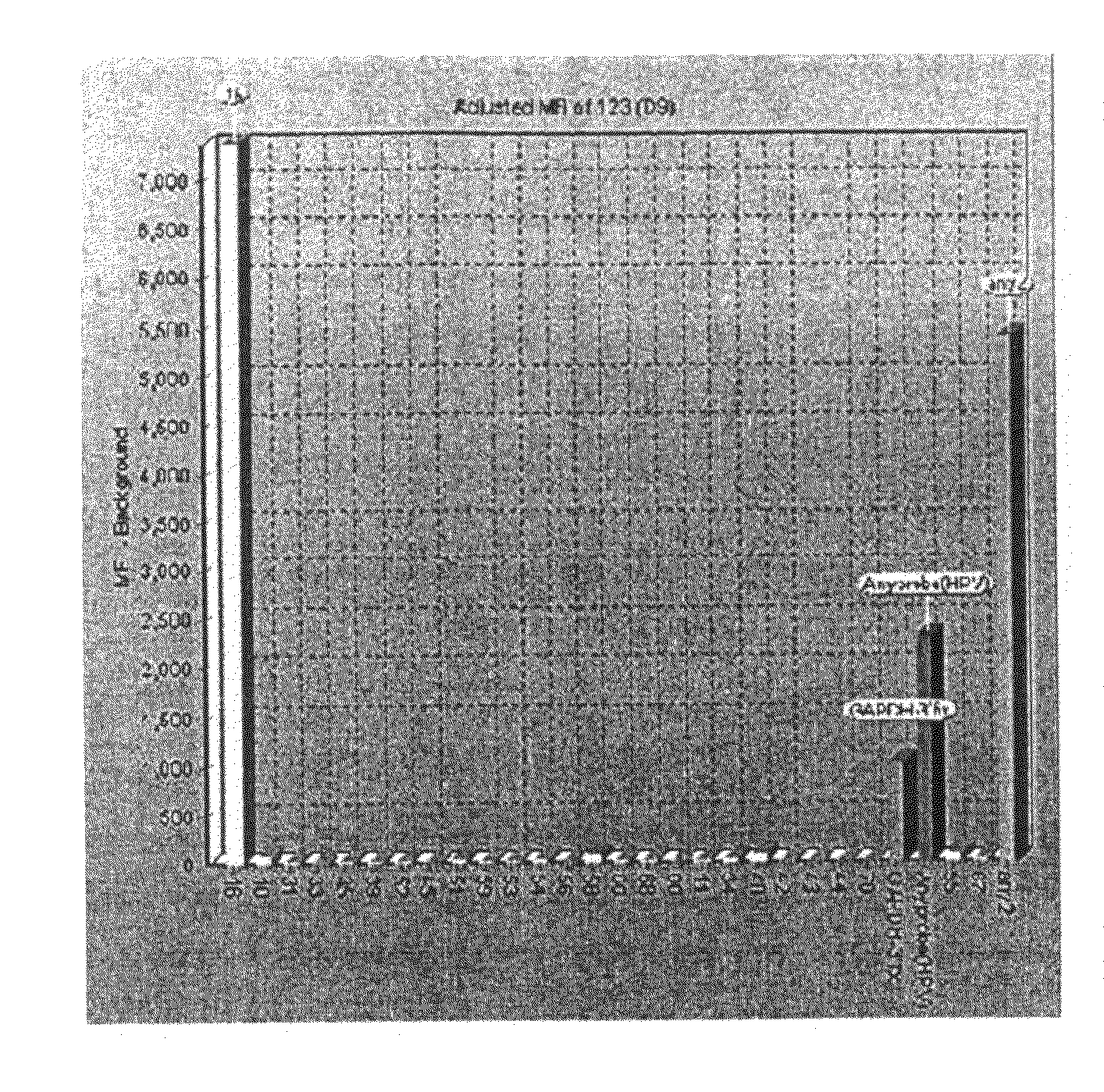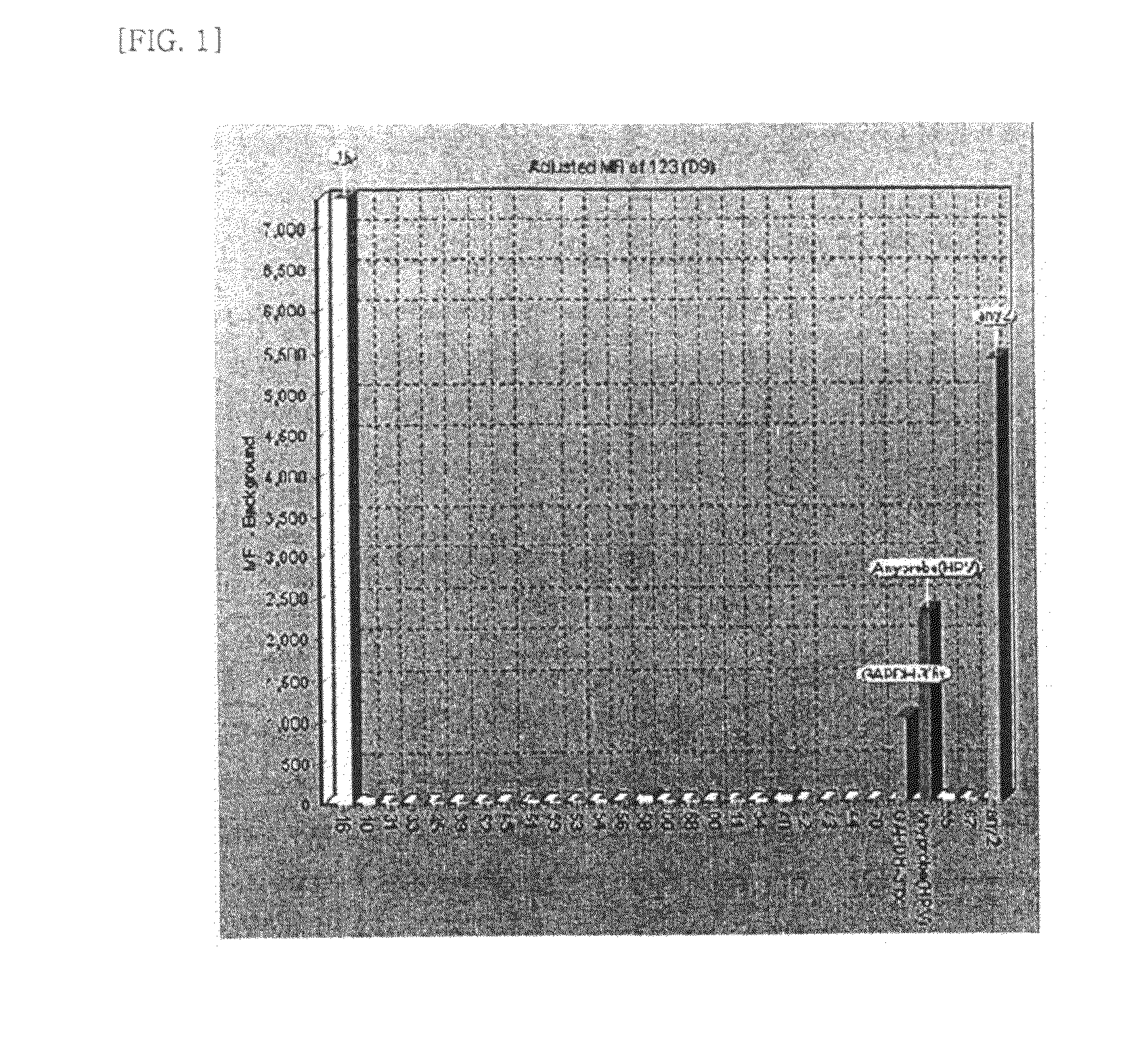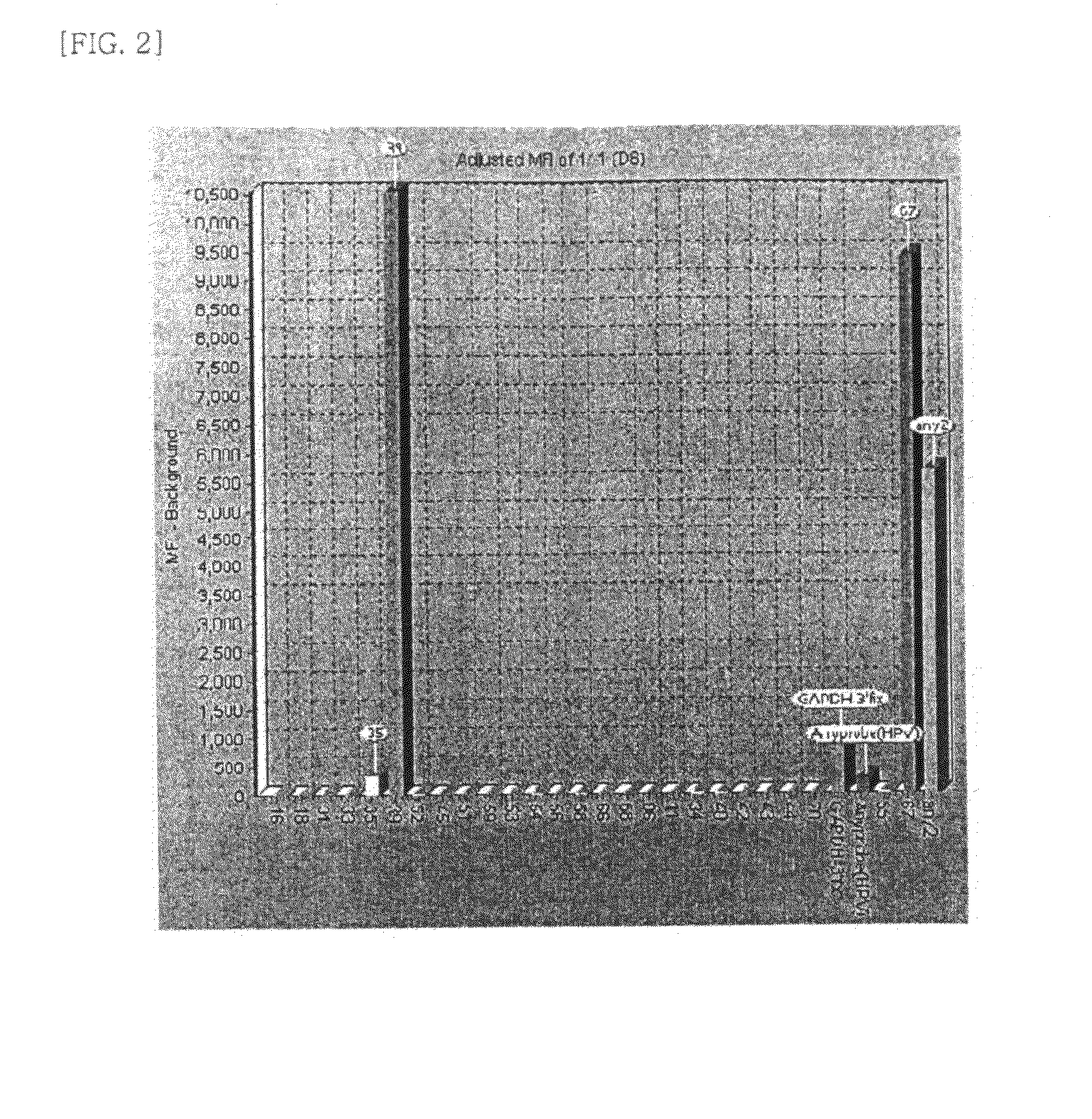Kits and Method For Detecting Human Papilloma Virus With Oligo Nucleotide Bead Array
a technology of human papillomavirus and oligo nucleotide, applied in the field of kits and methods for genotyping human papillomavirus (hpv), can solve the problems of inability to determine hpv genotypes, false or inaccurate test results, and difficult colposcopic screening
- Summary
- Abstract
- Description
- Claims
- Application Information
AI Technical Summary
Benefits of technology
Problems solved by technology
Method used
Image
Examples
example 1
Preparation of Probes and Bead Array
[0045]1-1. Preparation of Probes
[0046]20- to 27-mer oligonucleotide probes comprising 15 thymines (dTTP), 6 (CH2) chains and amine group, inclusive of HPV L1 gene, on the 5′, are immobilized to a bead array included in the detection kit.
[0047]Table 1 shows various probes used to detect HPV genotypes.
TABLE 1Probe 1type 165′-TGTGCTGCCATATCTACTTCAGA-3′(SEQ ID NO: 1)Probe 2type 185′-AGTCTCCTGTACCTGGGCAA-3′(SEQ ID NO: 2)Probe 3type 315′-GTGCTGCAATTGCAAACAGT-3′(SEQ ID NO: 3)Probe 4type 335′-TGCACACAAGTAACTAGTGACAGTACA-3′(SEQ ID NO: 4)Probe 5type 355′-CTGTGTGTTCTGCTGTGTCTTCT-3′(SEQ ID NO: 5)Probe 6type 395′-TTCCATACCTTCTACATATGATCCTTC-3′(SEQ ID NO: 6)Probe 7type 525′-GCTGAGGTTAAAAAGGAAAGCA-3′(SEQ ID NO: 7)Probe 8type 455′-CACAAAATCCTGTGCCAAGT-3′(SEQ ID NO: 8)Probe 9type 515′-ATTAGCACTGCCACTGCTGC-3′(SEQ ID NO: 9)Probe 10type 595′-TTCTGTGTGTGCTTCTACTACTTCTTC-3′(SEQ ID NO: 10)Probe 11type 535′-CCGCAACCACACAGTCTATG-3′(SEQ ID NO: 11)Probe 12type 545′-CATCCACG...
example 2
Assay of HPV Genotypes using Bead Array
[0060]2.1. Isolation of DNA from Samples
[0061]In order to isolate DNA from samples, uterine cervix cells sampled using a cotton swab were dissolved in 400 μl of a lysis solution and incubated in 10 μl of Proteinase K (20 mg / ml), followed by further reacting for about 15 minutes in boiling water.
[0062]2.2. PCR Amplification of HPV L1 Gene and a GAPDH Gene in DNA Sample
[0063]In order to detect and assay HPV genotypes, 5 μl of DNA prepared in Example 2-1 used as a template. The 1st PCR amplification of the HPV gene was performed with 0.4 uM of HPV primer set, 0.1 uM of GAPDH primer set, 0.1 mM of dNTP mix 75 mM of Tris HCl (pH 9.0), 20 ml of MgCl2, 50 mM of KCl, 20 mM of (NH4)2SO4, and 1.5 unit of Taq polymerase (Ultratools, Spain). The primers used herein have the following base sequences:
HPV primer sets(SEQ ID NO: 27)YBT L1 F:5′-gcmcagggwcayaayaatgg-3′(SEQ ID NO: 28)GP6-1:5′-aataaactgtaaatcatattcctc-3′GAPDH primer sets(SEQ ID NO: 29)GAPDH F:5′-g...
example 3
Assay Results of HPV Genotypes using Patient Samples
[0074]Hybridization mixture which is prepared by mixing beads and hybridization solution was added to each labeled sample product. After the hybridization and washing step, hybridized samples and streptavidin-phycoerythrin reacted together. This fluorescence (phycoerythrin) signal amount was calculated at the bead array instrument.
[0075]As confirmed from the assay result, the patient sample was infected with HPV type 16. It was also confirmed that GAPDH amplification was carried out successfully, suggesting that there was no failure in the PCR. As shown in FIG. 1, an Any-probe for identifying HPV infection was also detected.
PUM
| Property | Measurement | Unit |
|---|---|---|
| Sensitivity | aaaaa | aaaaa |
| Nucleic acid sequence | aaaaa | aaaaa |
| Fluorescence | aaaaa | aaaaa |
Abstract
Description
Claims
Application Information
 Login to View More
Login to View More - R&D
- Intellectual Property
- Life Sciences
- Materials
- Tech Scout
- Unparalleled Data Quality
- Higher Quality Content
- 60% Fewer Hallucinations
Browse by: Latest US Patents, China's latest patents, Technical Efficacy Thesaurus, Application Domain, Technology Topic, Popular Technical Reports.
© 2025 PatSnap. All rights reserved.Legal|Privacy policy|Modern Slavery Act Transparency Statement|Sitemap|About US| Contact US: help@patsnap.com



